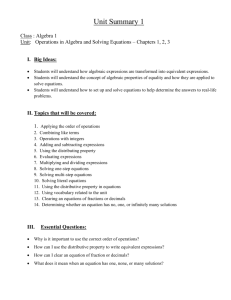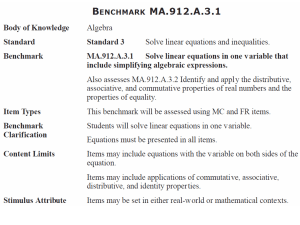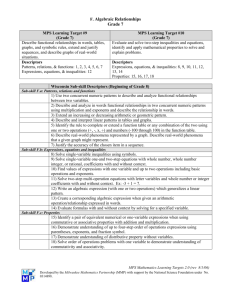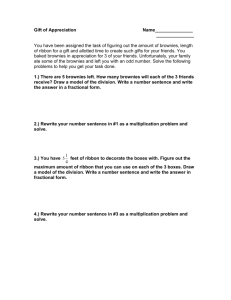Honors Algebra Unit 1 Summary (Solving Equations)
advertisement
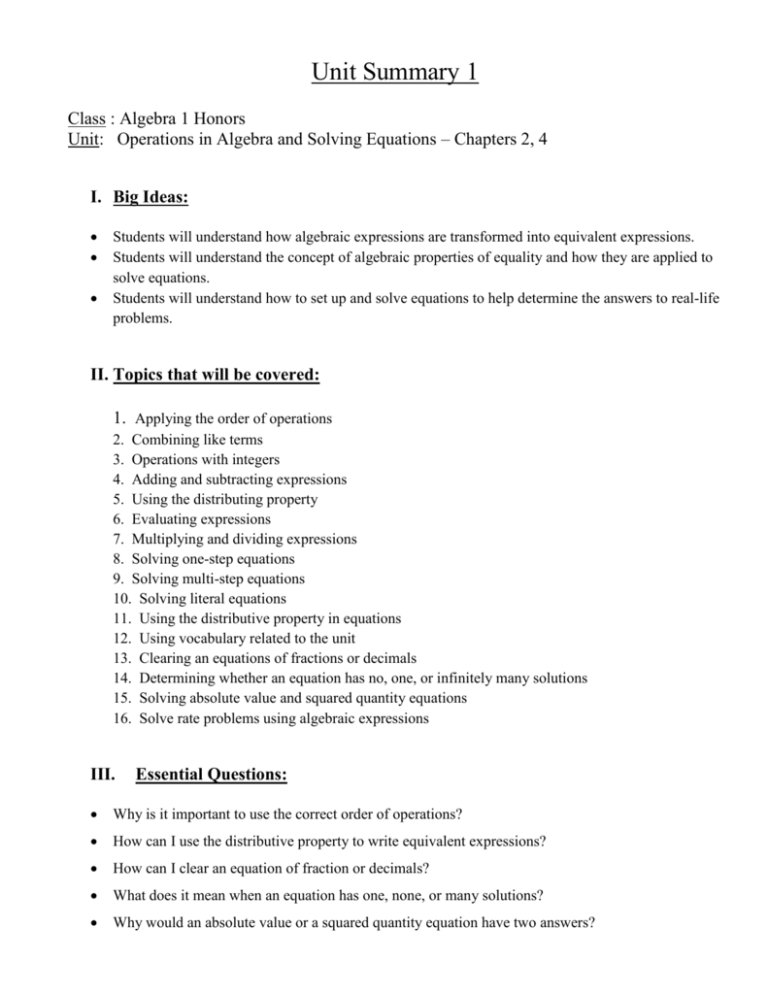
Unit Summary 1 Class : Algebra 1 Honors Unit: Operations in Algebra and Solving Equations – Chapters 2, 4 I. Big Ideas: Students will understand how algebraic expressions are transformed into equivalent expressions. Students will understand the concept of algebraic properties of equality and how they are applied to solve equations. Students will understand how to set up and solve equations to help determine the answers to real-life problems. II. Topics that will be covered: 1. Applying the order of operations 2. Combining like terms 3. Operations with integers 4. Adding and subtracting expressions 5. Using the distributing property 6. Evaluating expressions 7. Multiplying and dividing expressions 8. Solving one-step equations 9. Solving multi-step equations 10. Solving literal equations 11. Using the distributive property in equations 12. Using vocabulary related to the unit 13. Clearing an equations of fractions or decimals 14. Determining whether an equation has no, one, or infinitely many solutions 15. Solving absolute value and squared quantity equations 16. Solve rate problems using algebraic expressions III. Essential Questions: Why is it important to use the correct order of operations? How can I use the distributive property to write equivalent expressions? How can I clear an equation of fraction or decimals? What does it mean when an equation has one, none, or many solutions? Why would an absolute value or a squared quantity equation have two answers? IV. Sample questions to answer by the end of the unit: 1. George is in charge of supplies for a mountain climbing guide company. He is trying to locate carabineers for four climbing teams. George’s preferred brand of carabiners are available at three outfitters as follows: Outfitter A has 4 boxes plus 6 loose carabineers, outfitter B has 6 boxes but one box is missing 3 carabineers, outfitter C has 10 boxes plus 5 loose carabineers. Assuming each box contains an equal number of carabiners, write an expression describing the total number of carabineers available. Write another expression describing the number of carabiners available for each team if the carabineers are divided equally among the teams. 2. Orange County has a population of 25,000 people and is increasing by 3500 people each year. Hunterdon County has a population of 36,000 people and is increasing by 2700 people each year. At this rate, when would the two counties have the same number of people residing there? 3. Which equation has no solution? A) 2x + 4 = 2(x + 4) C) 3x + 5 = 2(x + 3) B) 2x + 4 = 2(x + 1) D) both A and B 4. The solution to the equation 3x + 9 = 8 is the same as the solution to the equation: A) 3x = 17 B) 3x + 1 = 0 C) 3x = 1 D) x + 3 = 8 5. Which of the following expressions is equivalent to the expression (5x – 2) – (3x – 5)? A) 2x – 3 B) 2x + 7 C) 2x – 7 D) 2x + 3 E) None of the above 6. If 5w + 2 = 30, then 4 A) 20w = 112 C) 5w = 118 E) 5w = 112 7. If 5(2x + 8) = 9x – 11, what does 5x =? B) 5w = 120 D) 5w = 7 F) None of the above 8. If 4(3x – 1) = (8x + 3)2, what does 4x = ? 9. Solve for y: 9x + 3y = 18 10. Solve for f: yx + f = 2 g 11. Solve for x: 15x – 3(2x + 4) = 4(x – 2) 12. Explain in sentence form the differences between the solutions of the following equations. A) x + 2 = 10 13. Solve for x: (x + 3)2 + 4(x + 3)2 = 180 14. Solve for x: 2x - 6 = 10 15. Solve for x: 3x + 2 + 4 = 21 B) x - 2 = -10 16. Brenda and Brian are baking brownies for a high school bake sale. Brenda can make 20 brownies per hour. Brian can make 25 per hour. Brian starts baking brownies at 1:30 and Brenda starts at 3:30. Let h represent the number of hours that Brian has been baking. A) Write an expression representing the number of hours that Brenda baked brownies. Use only one variable, h. B) Write an expression representing the number of brownies that Brenda baked in h hours. C) Write an equation to find the number of hours it would take Brenda and Brian to bake 130 brownies. Do not use any variable expect h. D) Solve the equation you wrote in part c.
